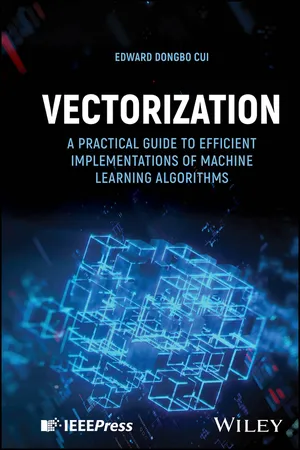
Vectorization
A Practical Guide to Efficient Implementations of Machine Learning Algorithms
- English
- PDF
- Available on iOS & Android
Vectorization
A Practical Guide to Efficient Implementations of Machine Learning Algorithms
About this book
Enables readers to develop foundational and advanced vectorization skills for scalable data science and machine learning and address real-world problems
Offering insights across various domains such as computer vision and natural language processing, Vectorization covers the fundamental topics of vectorization including array and tensor operations, data wrangling, and batch processing. This book illustrates how the principles discussed lead to successful outcomes in machine learning projects, serving as concrete examples for the theories explained, with each chapter including practical case studies and code implementations using NumPy, TensorFlow, and PyTorch.
Each chapter has one or two types of contents: either an introduction/comparison of the specific operations in the numerical libraries (illustrated as tables) and/or case study examples that apply the concepts introduced to solve a practical problem (as code blocks and figures). Readers can approach the knowledge presented by reading the text description, running the code blocks, or examining the figures.
Written by the developer of the first recommendation system on the Peacock streaming platform, Vectorization explores sample topics including:
- Basic tensor operations and the art of tensor indexing, elucidating how to access individual or subsets of tensor elements
- Vectorization in tensor multiplications and common linear algebraic routines, which form the backbone of many machine learning algorithms
- Masking and padding, concepts which come into play when handling data of non-uniform sizes, and string processing techniques for natural language processing (NLP)
- Sparse matrices and their data structures and integral operations, and ragged or jagged tensors and the nuances of processing them
From the essentials of vectorization to the subtleties of advanced data structures, Vectorization is an ideal one-stop resource for both beginners and experienced practitioners, including researchers, data scientists, statisticians, and other professionals in industry, who seek academic success and career advancement.
Frequently asked questions
- Essential is ideal for learners and professionals who enjoy exploring a wide range of subjects. Access the Essential Library with 800,000+ trusted titles and best-sellers across business, personal growth, and the humanities. Includes unlimited reading time and Standard Read Aloud voice.
- Complete: Perfect for advanced learners and researchers needing full, unrestricted access. Unlock 1.4M+ books across hundreds of subjects, including academic and specialized titles. The Complete Plan also includes advanced features like Premium Read Aloud and Research Assistant.
Please note we cannot support devices running on iOS 13 and Android 7 or earlier. Learn more about using the app.
Information
Table of contents
- Cover
- Title Page
- Copyright
- Contents
- About the Author
- Preface
- Acknowledgment
- Chapter 1 Introduction to Vectorization
- Chapter 2 Basic Tensor Operations
- Chapter 3 Tensor Indexing
- Chapter 4 Linear Algebra
- Chapter 5 Masking and Padding
- Chapter 6 String Processing
- Chapter 7 Sparse Matrix
- Chapter 8 Jagged Tensors
- Chapter 9 Groupby, Apply, and Aggregate
- Chapter 10 Sorting and Reordering
- Chapter 11 Building a Language Model from Scratch
- Index
- EULA